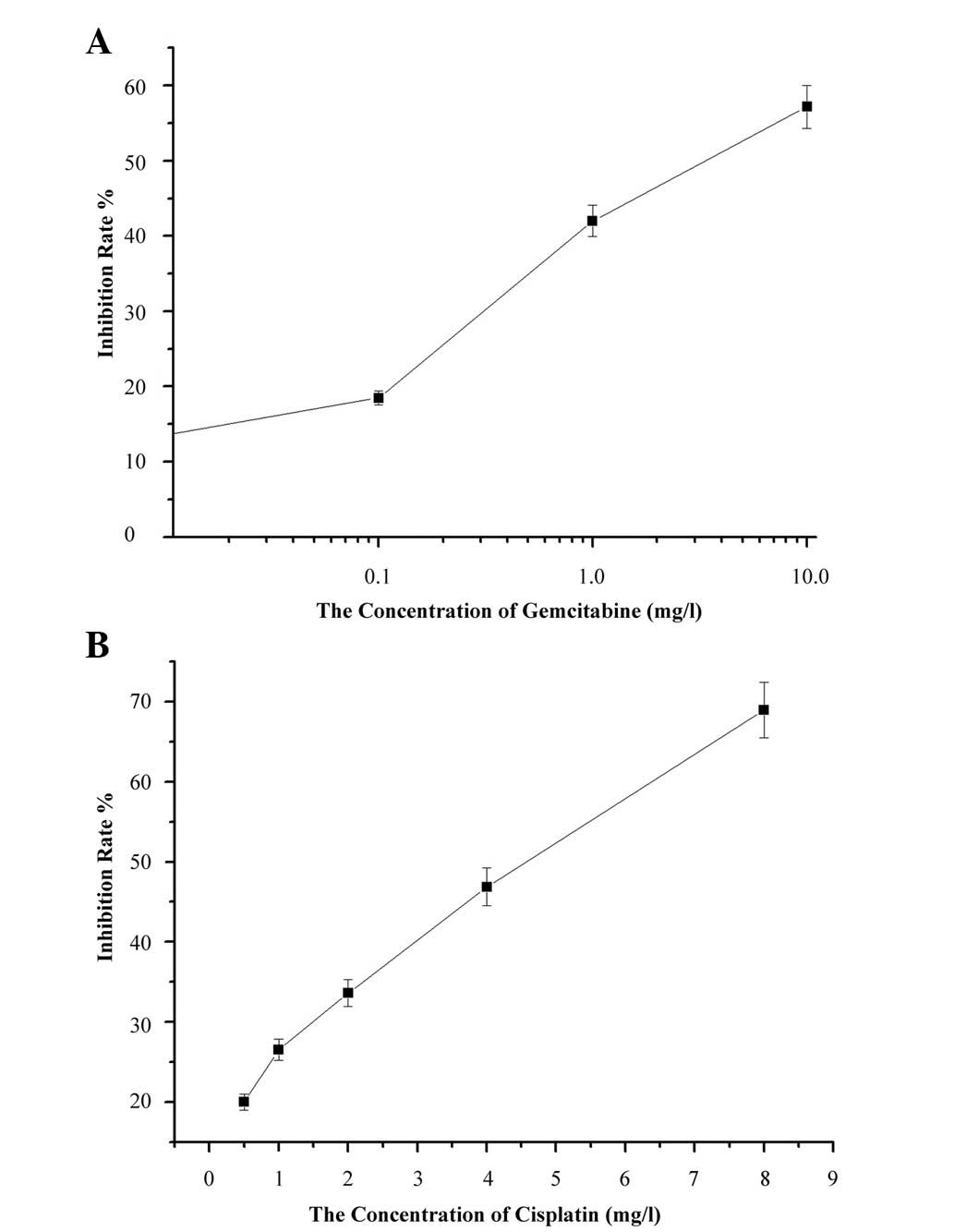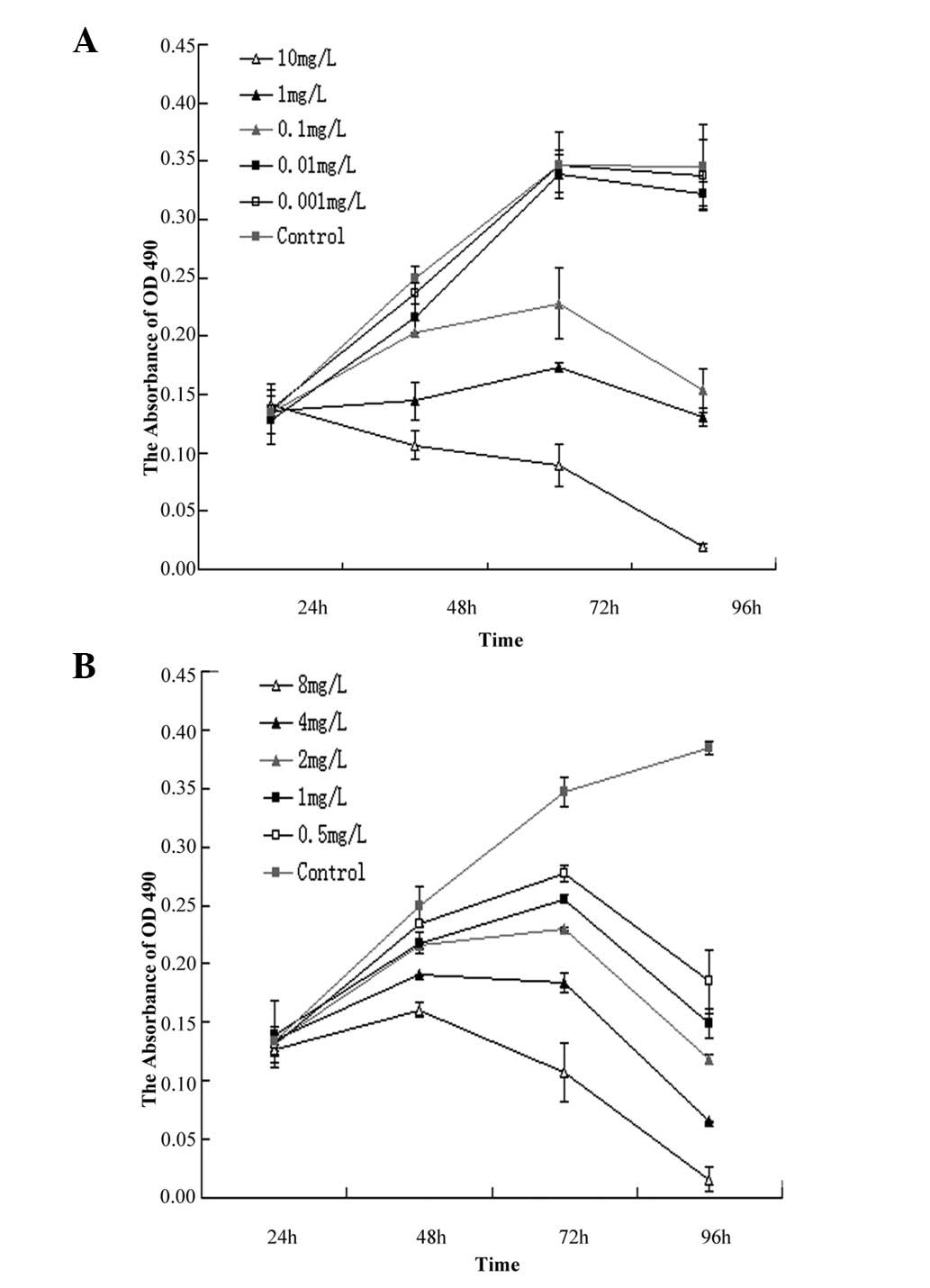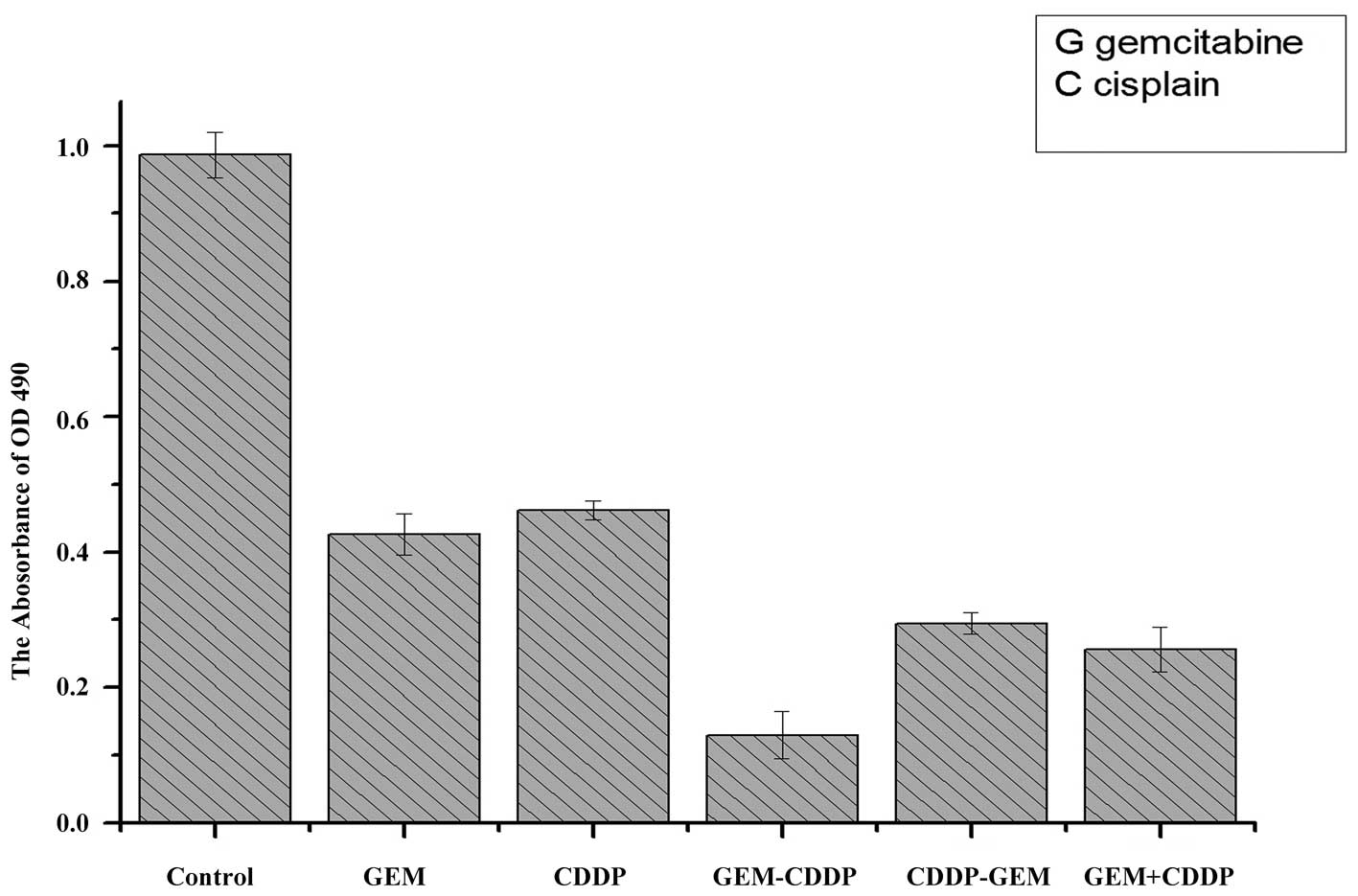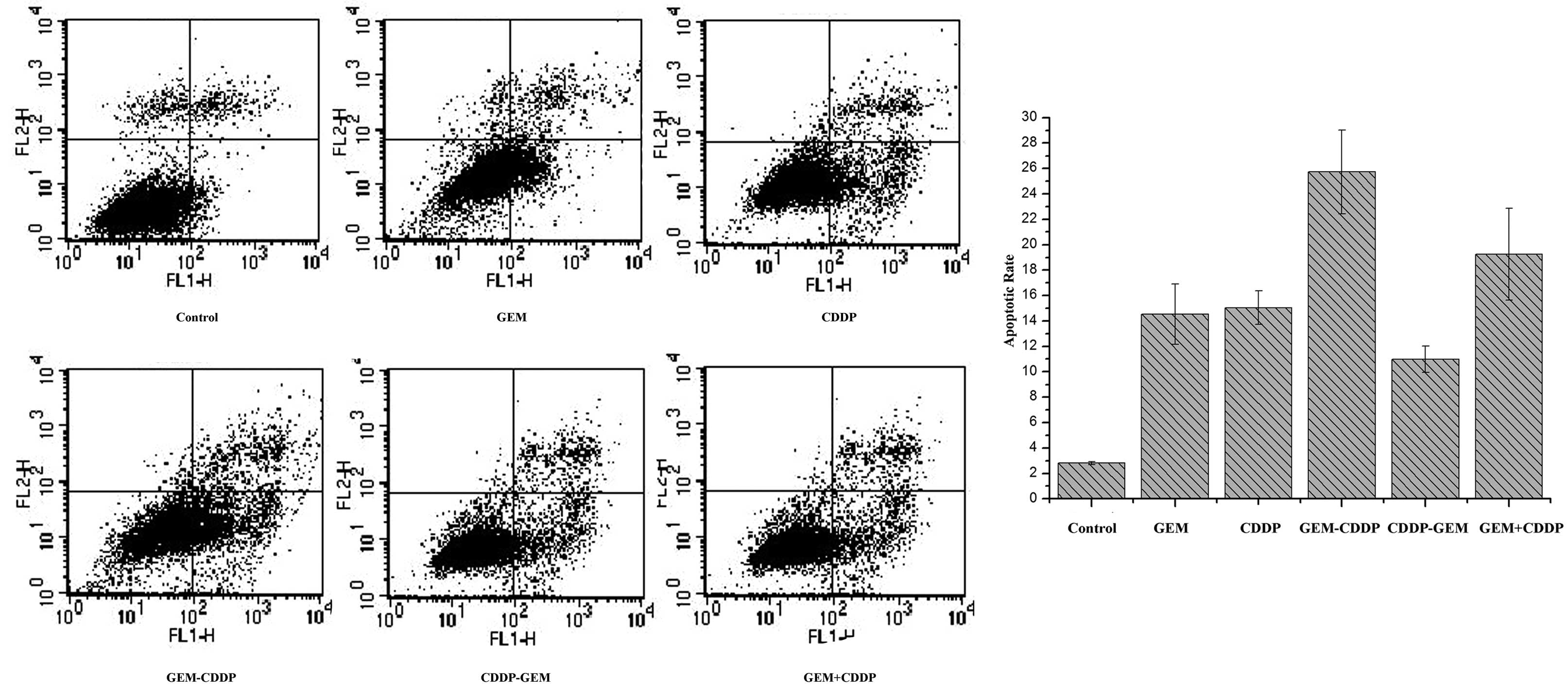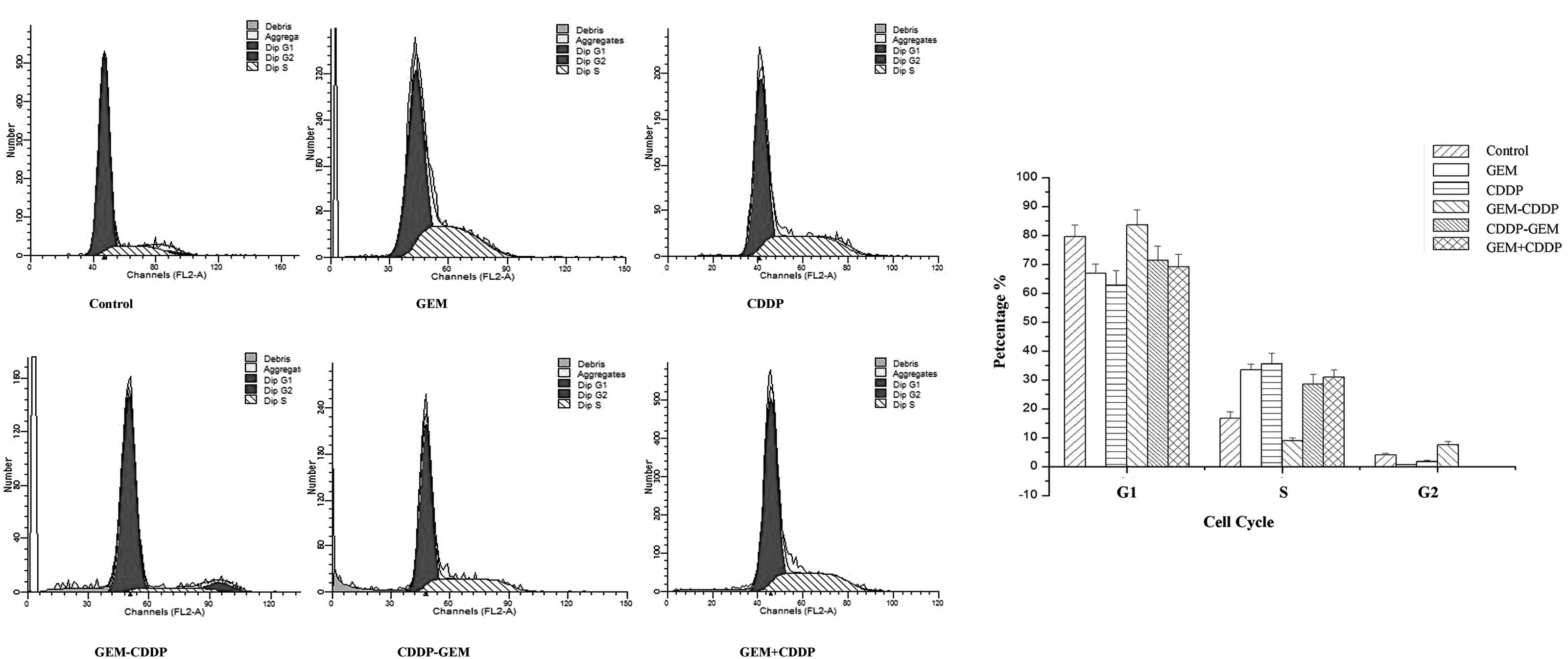Sequence‑dependent effect of gemcitabine and cisplatin on A549 non‑small‑cell lung cancer cells
- Authors:
- Published online on: May 28, 2013 https://doi.org/10.3892/mmr.2013.1495
- Pages: 221-226
Abstract
Introduction
Non-small-cell lung cancer (NSCLC) is the most common type of lung cancer, with a mortality rate of >80%. However, the value of chemotherapy in the treatment of NSCLC is controversial. To date, cis-diamminedichloroplatinum (cisplatin, CDDP) remains one of the most important drugs for combination chemotherapy (1). In 1995, a meta-analysis was performed to investigate the impact of CDDP-containing combination chemotherapy (2,3). The results indicated that patients administered with CDDP-containing combination chemotherapy revealed a small but significant 10% survival benefit at 12 months compared with the best supportive care in advanced NSCLC. As a result of these observations, CDDP-containing combination chemotherapy has been commonly used for the treatment of NSCLC; however, the treatment efficacy remains unsatisfactory (4). 2′,2′-Difluorodeoxycytidine (gemcitabine, GEM), an active antineoplastic agent for NSCLC, has been previously hypothesized to be suitable for use in combination with CDDP, following observations indicating that these drugs may exhibit complementary mechanisms (5). The sequence-dependent effects of CDDP/GEM treatment remain an important area of clinical and experimental studies, with results demonstrating that various treatment protocols affect the outcome of combination chemotherapy. Previous studies have reported that GEM followed by CDDP represents the most effective treatment in in vitro and in vivo models (6–10). The present study aimed to investigate the sequence-dependent effects of CDDP/GEM treatment on the human non-small-cell lung carcinoma cell line, A549.
Materials and methods
Chemicals and reagents
GEM and CDDP were purchased from Jiangsu Hansoh Pharmaceutical Co., Ltd. (Lianyungang, China). GEM and CDDP were dissolved in 0.9% NaCl and sterile-filtered. Drug concentrations were set according to their respective IC50 values, followed by serial dilutions. In the GEM group, the concentrations used were 0.001, 0.01, 0.1, 1 and 10 mg/l. In the CDDP group, the concentrations were 0.5, 1, 2, 4 and 8 mg/l, respectively.
Cell culture
A549 cells were grown in monolayers in Dulbecco's modifed Eagle's medium (Gibco, Invitrogen, NY, USA) supplemented with 10% heat-inactivated fetal bovine serum (Hyclone, Logan, UT, USA), 1% L-glutamine and 1% penicillin-streptomycin and incubated at 37°C in 5% CO2. The study was approved by the Institutional Review Board at Liaoning Tumor Hospital (Shenyang, China).
Drug administration
In this study, the cells were divided into six groups, including a control group and five treatment groups. The treatment groups were as follows: GEM, CDDP, GEM followed by CDDP (GEM - CDDP), CDDP followed by GEM (CDDP - GEM) and simultaneous administration of GEM and CDDP (GEM + CDDP). To study the sequence-dependent effects of treatments, cultured cells were exposed to GEM and CDDP alone and in combination. Cells were treated with the first drug for 24 h, at concentrations of IC50, 75% IC50, 50% IC50 and 25% IC50. The cells were then washed with PBS and treated with the second drug, also at concentrations of IC50, 75% IC50, 50% IC50 and 25% IC50, with the same dilution ratios for both drugs.
Inhibition rate
A549 cells at the exponential growth phase were plated in 96-well plates (5×103 cells in a volume of 100 μl medium/well). Following cell adherence, 100 μl GEM (final concentrations, 0.001, 0.01, 0.1, 1 and 10 mg/l) and/or CDDP (final concentrations, 0.5, 1, 2, 4 and 8 mg/l) were added to the medium. Cells were cultured at 37°C for 48 h. Next, medium in the control and drug-containing wells was removed and replaced by 200 μl fresh, drug-free MTT medium (0.5 mg/ml; Sigma, St. Louis, MO, USA). Following culture for 4 h at 37°C, the medium was replaced by 150 μl dimethyl sulfoxide (DMSO; Sigma). Finally, a microplate reader (Tecan, Männedorf, Switzerland) was used to detect the optical density (OD) values in each group at a wavelength of 490 nm. Each group was performed in triplicate in three independent experiments. Inhibition rates and IC50 were calculated based on these values.
Calculation of combination index (CI)
CI was calculated using the following formula (11): CI = (Da/aIC50) + (Db/bIC50), where a and b represent two drugs with a similar function. Da and Db represent doses that lead to a growth inhibition of 50%. aIC50 and bIC50 represent the drug concentration at which an inhibition rate of 50% was achieved. CI<1 indicated synergism, CI>1 indicated antagonism and CI=1 indicated additivity. The inhibition rate was calculated based on an MTT assay and the IC50 was calculated using logistic analysis.
Cell cycle analysis
Cells were exposed to cisplatin and/or gemcitabine treatment. Following 48 h, cells were washed with ice-cold PBS, recovered by trypsinization, fixed in 70% cold ethanol and stored at 4°C. Following centrifugation, 500 μl resuspended cells with a concentration of 1.0×106/ml were collected. Next, propidium iodide (PI) solution was added and incubated for 45 min at room temperature (in the dark). Flow cytometric analysis was performed with a BD FACScan flow cytometer (Becton Dickinson, San Jose, CA, USA) using a 480 nm laser as an excitation source and an absorbance wavelength of 630 nm.
Analysis of apoptosis
Apoptotic cells were identified using the BD Pharmingen FITC Annexin V Apoptosis Detection kit (San Diego, CA, USA), according to the manufacturer's instructions. Annexin V is a 35–36 kDa Ca2+-dependent phospholipid-binding protein that binds phosphatidylserine, a phospholipid continuously exposed in apoptotic cells. Annexin V conjugates with FITC, a fluorochrome, functioning as a sensitive probe for the flow cytometry of cells undergoing apoptosis. Damaged cells were stained by PI. Cells were plated in 6-well plates and divided into 6 groups. Following drug treatment, cells were collected and washed twice with cold PBS. Next, cells were resuspended in binding buffer at a concentration of 1.0×106 cells/ml. In addition, 100 μl solution was added to 5-ml culture tubes together with 5 μl FITC Annexin V and 5 μl PI. Cells were incubated for 15 min at room temperature under dark conditions. Binding buffer (400 μl) was added to the tubes and analyzed using the BD FACScan flow cytometer.
Statistical analysis
The SPSS 13.0 statistical software package (SPSS, Inc., Chicago, IL, USA) was used for statistical analysis. The results of cells treated with different drugs were analyzed by one-way ANOVA. Pearson correlation analysis was used to analyze the dose- and time-dependent effects. P<0.05 was considered statistically significant.
Results
Dose and time-dependent effects of GEM and CDDP
To investigate the dose- and time-dependent effects of GEM and CDDP on A549 cells, cells were treated with GEM alone with concentrations of 0.1 to 1 mg/l or CDDP alone with concentrations of 0.5, 1, 2 and 4 mg/l, respectively. MTT assay was performed to detect cell viability 24, 48 and 72 h after drug exposure. Pearson correlation analysis indicated a dose-effect relationship in the GEM (r=0.827; P<0.05) and CDDP groups (r=0.983; P<0.01) within 24 h (Fig. 1). A time-dependent was also observed in Fig. 2. In the GEM group, IC50 for 24, 48 and 72 h was 3.79±0.32, 1.11±0.12 and 0.23±0.06 mg/l, respectively (Fig. 2A). In the CDDP group, IC50 for 24, 48 and 72 h was 18.58±2.01, 3.78±0.25, and 0.76±0.10 mg/l, respectively (Fig. 2B).
Sequence-dependent effects of GEM and CDDP on the inhibition of cell growth
To investigate the sequence-dependent effects of GEM and CDDP on the inhibition of A549 cells, drug administration with different sequences was performed on cells. When the inhibition rate reached 50%, the concentration for GEM was 0.39±0.01 mg/l and 1.32±0.03 mg/l for CDDP in the GEM-CDDP group; the concentration for GEM was 0.65±0.03 mg/l and 2.21±0.04 mg/l for CDDP in the CDDP-GEM group; the concentration for GEM was 0.58±0.02 mg/l and 1.80±0.03 mg/l for CDDP in the GEM+CDDP group. Inhibition rate and CIs for different groups are presented in Table I. Compared with the control group (Fig. 3), significant inhibitory effects were observed in the GEM and CDDP groups. The sequence-dependent effects of GEM and CDDP were also determined in this study; the GEM - CDDP group revealed the highest rate of inhibition compared with the remaining five groups, indicating that GEM - CDDP chemotherapy exhibited the highest efficiency for killing A549 cells in vivo.
Sequence-dependent effects of GEM and CDDP on apoptosis
The concentration of GEM and CDDP in the combination is based on their respective IC50 values. As demonstrated in Fig. 4, the apoptotic rate in the control group was 2.82±0.12%. In the GEM group, the apoptotic rate was 14.54±2.36%, while that of the CDDP group was 15.06±1.31%. In the combination groups, the rates of apoptosis were 25.72±3.29, 10.99±1.04 and 19.24±3.61% in the GEM - CDDP, CDDP - GEM and GEM + CDDP groups, respectively. Among these groups, GEM - CDDP revealed the highest rate of apoptosis compared with the other groups (P<0.05).
Sequence-dependent effects of GEM and CDDP on the cell cycle
In this study, the sequence-dependent effects of various treatment protocols on the cell cycle were determined (Fig. 5). In groups treated with GEM or CDDP, an increased percentage of cells were arrested in the S phase compared with the control group (P<0.05). Although the amount of cells arrested in the S phase in the CDDP group was larger than that in the GEM group, no statistical difference was observed. Consistent results were also detected in the CDDP - GEM, CDDP and GEM groups, where an increased percentage of cells were arrested in the S phase compared with the control group (P<0.05). GEM - CDDP was identified to exhibit the highest rate of apoptosis, with the majority of cells arrested in the G1 and G2 phases.
Discussion
CDDP is one of the most widely used anticancer drugs, due to its broad spectrum of activities. CDDP has revealed specific clinical activity for the treatment of NSCLC; however, CDDP induces nephro- and neurotoxicity, ototoxicity, severe nausea, and vomiting (12) and is often withheld from elderly people (13). Therefore, the identification of novel therapeutic approaches with mild toxicities is required to improve the clinical outcome of NSCLC. GEM has been hypothesized to be an excellent candidate for combination therapy, as it is associated with moderate side-effects and dose-dependent toxicity. The combination of GEM and CDDP represents an attractive candidate for combination chemotherapy, as the drugs exhibit complementary mechanisms and non-overlapping side effects (14).
Results of the present study indicate that CDDP and GEM exert synergistic effects in vitro, consistent with previous observations (5). In addition, the effect of sequence of drug administration on the outcome of GEM/CDDP treatment was investigated, and it was identified that the administration of GEM followed by CDDP represented the most efficient treatment protocol, consistent with a number of in vitro and in vivo studies (15–18).
GEM functions by blocking nucleic acid synthesis and enzymes involved in the nucleotide biosynthesis pathway. The drug inhibits DNA synthesis and the DNA repair process by reducing the levels of deoxynucleoside triphosphate recruited during DNA synthesis and repair. To date, GEM is considered to be one of the most efficient chemotherapeutic drugs, as it inhibits cell proliferation by preventing cells from progressing from the G1 to the S phase. At present, GEM/CDDP combination therapy is preferred for the treatment of advanced NSCLC. Despite previous observations indicating that the administration of GEM/CPPD following an appropriate protocol leads to the synergistic interaction of the drugs (17), high levels of morbidity and a marginal impact on survival time have rendered this combination unsatisfactory. Based on these observations, the aim of the current study was to investigate the sequence-dependent effects of GEM/CDDP treatment in the NSCLC cell line, A549, which is one of the most drug-resistant human tumor cells.
Previous studies have reported sequence-dependent effects of GEM and CDDP in tumor cells. van Moorsel et al(15) reported synergism between GEM and CDDP in NSCLC tumor Lewis lung carcinomas in C57/B16 mice. In addition, Crino et al reported a 54% efficacy rate in a group treated with GEM followed by CDDP in a phase II NSCLC trial (16). In the trial, 48 previously untreated patients with NSCLC were analyzed. GEM was administered weekly at a dose of 1 g/ml and CDDP was administered at a dose of 100 mg/ml on day 2 of each 28-day cycle. The results indicated that GEM administration followed by CDDP induced a high response rate in stage IIIB and IV NSCLC (16). Finally, antagonism was reported in a study performed with CDDP administration followed by GEM (concentration, 60% of the IC50) for 24 h (18). Results of the present study are consistent with these observations, providing further evidence for the sequence- and dose-dependent effects of GEM and CDDP therapy on tumor cells.
A number of variables, including the schedule, dose and type of study, are considered to be important for the efficacy of administration of GEM and CDDP combination. However, the mechanisms by which these drugs mediate their effects remain unclear.
In the present study, synergism was observed in the group treated with GEM followed by CDDP at12 h. Antagonism was observed in the group treated with CDDP followed by GEM at 12 h. Additivity was observed in the group treated with GEM and CDDP simultaneously. Results of previous studies, together with the present study, indicate the presence of sequence-dependent effects of GEM and CDDP treatment, and suggest that these are dependent on dosage, schedule and cell lines to a significant extent. However, at present, no mechanisms accounting for the synergism between GEM and CDDP have been hypothesized. In the current study, analysis of the cell cycle was performed to determine whether the cell cycle is involved in the sequence-dependent effects of GEM and CDDP treatment. Cells treated with GEM or CDDP alone induced cell arrest in the S phase, with increased rates of cell apoptosis. Cells treated with CDDP - GEM or CDDP + GEM exhibited an increased proportion of cells arrested in the S phase, while in the GEM - CDDP group, cells were arrested in the G1 and G2 phases. The interaction between CDDP and GEM enables CDDP to affect the incorporation of GEM into DNA and RNA in a cell line-dependent manner (19). In addition, a marked effect on DNA synthesis was noted following administration of CDDP. Thus, CDDP may affect the interaction of GEM with DNA. GEM increases the cellular uptake of CDDP and subsequent DNA-platination (20,21). In a previous study, nucleotide excision repair was observed to occur when CDDP was administered and followed by GEM (6). In addition, levels of ribonucleotide reductase, the target of GEM, increased significantly during the inhibition of DNA synthesis. As CDDP is known to inhibit ribonucleotide reductase, the inhibitory effect of CDDP on ribonucleotide reductase may be reduced by GEM metabolism. In studies performed with GEM followed by CDDP, the accumulation of single- and double-strand breaks was significant and intracellular CDDP was hypothesized to generate active products that form DNA intra- and interstrand cross-links (22,23), increasing the probability of the induction of cell apoptosis.
Emerging drugs, particularly molecular targeted therapies, represent novel options for drug combination therapies (24). Specifically, the epidermal growth factor receptor tyrosine kinase inhibitor, gefitinib (25), and histone deacetylation inhibitors (26,27) have been combined with traditional chemotherapy drugs, demonstrating promising efficacies and novel insights into NSCLC therapies.
In conclusion, results of the current study indicate that drug administration sequence is an important variable in the efficacy of drug combination chemotherapy. These observations are likely to provide insight into the synergism of GEM followed by CDDP.
References
|
Kroep JR, Peters GJ, van Moorsel CJ, et al: Gemcitabine-cisplatin: A schedule finding study. Ann Oncol. 10:1503–1510. 1999. View Article : Google Scholar : PubMed/NCBI | |
|
No authors listed. Chemotherapy in non-small cell lung cancer: a meta-analysis using updated data on individual patients from 52 randomised clinical trials. Non-Small Cell Lung Cancer Collaborative Group. BMJ. 311:899–909. 1995. View Article : Google Scholar : PubMed/NCBI | |
|
No authors listed. Clinical practice guidelines for the treatment of unresectable non-small-cell lung cancer. Adopted on May 16, 1997 by the American Society of Clinical Oncology. J Clin Oncol. 15:2996–3018. 1997.PubMed/NCBI | |
|
Berghmans T, Paesmans M, Lalami Y, et al: Activity of chemotherapy and immunotherapy on malignant mesothelioma: a systematic review of the literature with meta-analysis. Lung Cancer. 38:111–121. 2002. View Article : Google Scholar : PubMed/NCBI | |
|
Braakhuis BJ, van Dongen GA, Vermorken JB and Snow GB: Preclinical in vivo activity of 2′,2′-difluorodeoxycytidine (Gemcitabine) against human head and neck cancer. Cancer Res. 51:211–214. 1991. | |
|
van Moorsel CJ, Veerman G, Bergman AM, et al: Combination chemotherapy studies with gemcitabine. Semin Oncol. 24(2 Suppl 7): S7-17–S7-23. 1997. | |
|
Peters GJ, Ruiz van Haperen VW, Bergman AM, et al: Preclinical combination therapy with gemcitabine and mechanisms of resistance. Semin Oncol. 23(5 Suppl 10): 16–24. 1996.PubMed/NCBI | |
|
Braakhuis BJ, Ruiz van Haperen VW, Welters MJ and Peters GJ: Schedule-dependent therapeutic efficacy of the combination of gemcitabine and cisplatin in head and neck cancer xenografts. Eur J Cancer. 31A:2335–2340. 1995. View Article : Google Scholar : PubMed/NCBI | |
|
Bergman AM, Ruiz van Haperen VW, Veerman G, et al: Synergistic interaction between cisplatin and gemcitabine in vitro. Clin Cancer Res. 2:521–530. 1996.PubMed/NCBI | |
|
Tsai CM, Chang KT, Chen JY, et al: Cytotoxic effects of gemcitabine-containing regimens against human non-small cell lung cancer cell lines which express different levels of p185neu. Cancer Res. 56:794–801. 1996. | |
|
Chou TC and Talalay P: Quantitative analysis of dose-effect relationships: the combined effects of multiple drugs or enzyme inhibitors. Adv Enzyme Regul. 22:27–55. 1984. View Article : Google Scholar : PubMed/NCBI | |
|
McKeage MJ: Comparative adverse effect profiles of platinum drugs. Drug Saf. 13:228–244. 1995. View Article : Google Scholar : PubMed/NCBI | |
|
Bunn PA Jr: Chemotherapy for advanced non-small-cell lung cancer: who, what, when, why? J Clin Oncol. 20:23S–33S. 2002.PubMed/NCBI | |
|
Voigt W, Bulankin A, Müller T, et al: Schedule-dependent antagonism of gemcitabine and cisplatin in human anaplastic thyroid cancer cell lines. Clin Cancer Res. 6:2087–2093. 2000.PubMed/NCBI | |
|
van Moorsel CJ, Pinedo HM, Veerman G, et al: Scheduling of gemcitabine and cisplatin in Lewis lung tumour bearing mice. Eur J Cancer. 35:808–814. 1999.PubMed/NCBI | |
|
Crinò L, Scagliotti G, Marangolo M, et al: Cisplatin-gemcitabine combination in advanced non-small-cell lungcancer: a phase II study. J Clin Oncol. 15:297–303. 1997. | |
|
Zanellato I, Boidi CD, Lingua G, et al: In vitro anti-mesothelioma activity of cisplatin-gemcitabine combinations: evidence for sequence-dependent effects. Cancer Chemother Pharmacol. 67:265–273. 2010. View Article : Google Scholar : PubMed/NCBI | |
|
Voigt W, Bulankin A, Müller T, et al: Schedule-dependent antagonism of gemcitabine and cisplatin in human anaplastic thyroid cancer cell lines. Clin Cancer Res. 6:2087–2093. 2000.PubMed/NCBI | |
|
Jackson RC: Amphibolic drug combinations: the design of selective antimetabolite protocols based upon the kinetic properties of multienzyme systems. Cancer Res. 53:3998–4003. 1993.PubMed/NCBI | |
|
Eastman A: The formation, isolation and characterization of DNA adducts produced by anticancer platinum complexes. Pharmacol Ther. 34:155–166. 1987. View Article : Google Scholar : PubMed/NCBI | |
|
Bunch RT and Eastman A: 7-Hydroxystaurosporine (UCN-01) causes redistribution of proliferating cell nuclear antigen and abrogates cisplatin-induced S-phase arrest in Chinese hamster ovary cells. Cell Growth Differ. 8:779–788. 1997. | |
|
Karagiannis TC and El-Osta A: Double-strand breaks: signaling pathways and repair mechanisms. Cell Mol Life Sci. 61:2137–2147. 2004.PubMed/NCBI | |
|
Bergstralh DT and Sekelsky J: Interstrand crosslink repair: can XPF-ERCC1 be let off the hook? Trends Genet. 24:70–76. 2008. View Article : Google Scholar : PubMed/NCBI | |
|
Pérol M, Chouaid C, Pérol D, et al: Randomized, phase III study of gemcitabine or erlotinib maintenance therapy versus observation, with predefined second-line treatment, after cisplatin-gemcitabine induction chemotherapy in advanced non-small-cell lung cancer. J Clin Oncol. 30:3516–3524. 2012. | |
|
Hida T, Ogawa S, Park JC, et al: Gefitinib for the treatment of non-small-cell lung cancer. Expert Rev Anticancer Ther. 9:17–35. 2009. View Article : Google Scholar : PubMed/NCBI | |
|
Ozaki K, Kishikawa F, Tanaka M, et al: Histone deacetylase inhibitors enhance the chemosensitivity of tumor cells with cross-resistance to a wide range of DNA-damaging drugs. Cancer Sci. 99:376–384. 2008. View Article : Google Scholar : PubMed/NCBI | |
|
Donadelli M, Costanzo C, Beghelli S, et al: Synergistic inhibition of pancreatic adenocarcinoma cell growth by trichostatin A and gemcitabine. Biochim Biophys Acta. 1773:1095–1106. 2007. View Article : Google Scholar : PubMed/NCBI |



